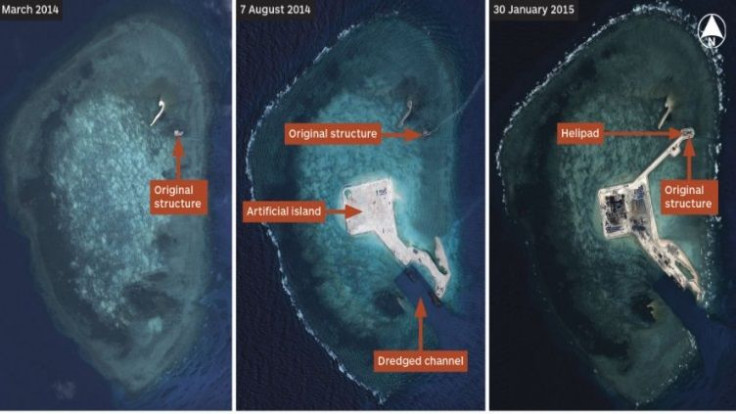PLA Officials Say South China Sea Reclamation To Boost Search And Rescue Abilities In Region

In the past, China’s presence in the disputed South China Sea waters was based on what it says are historical claims to the area. Now, China is shifting its narrative from a so-called regional military “reclamation” effort based on sovereignty claims to one that boasts humanitarian contributions for the region.
Despite international criticism, China has unabashedly forged ahead with its plans to "reclaim" areas of the waters disputed by Vietnam, the Philippines, Brunei and Malaysia, dredging up materials to establish man-made islands as outposts for the Chinese navy.
According to a new report by the China Daily, China’s added infrastructure in disputed islands and reefs in the South China Sea are being built as a regional search-and-rescue resource. Yun Zhuo, the director of the Expert Consultation Committee of the People’s Liberation Army Navy, told the newspaper that as the region's largest military force China has international responsibilities to perform rescue operations in the South China Sea in the event of an emergency.
“However, if our rescue team is based in [China’s southernmost] Hainan province, it will take several days for large ships to reach the scene of a wreck, and aircraft will have short ranges due to fuel limitations,” Yun said. “So it is very necessary to construct or upgrade infrastructure on islands and reefs in the South China Sea, as we can then send rescue ships and planes there in case of emergency.”
Admiral Wu Shengli adds that further construction in the area by China will enhance “capabilities to provide public services such as weather forecasting and maritime assistance.”
According to a report last week, Chinese officials said that the U.S., a regional ally to the Philippines, and other international organizations were all welcome to use civilian facilities on the controversial islands.
Yun cites China’s efforts in the search for Flight MH370 last March as a key example of how China’s abilities to dispense resources were hampered by having limited resources available in the South China Sea. “Anyone can see from the hunt for Malaysia Airlines Flight MH370 that China lacks a sufficient maritime search-and-rescue force in the South China Sea.”
Despite China’s seemingly innocuous proposal, territorial dispute adversaries in the area have been wary of similar claims in the past. At the height of the search for the missing Malaysia Airlines flight, officials from surrounding ASEAN nations expressed concern that China was exploiting the tragedy to gain undeterred presence in the area and establish itself as a geopolitical leader there, solidifying its claims, which some say it did successfully.
It appears that their caution was not unfounded. Since last March, China has built islands in at least three reef areas of the Spratly Islands at a startling pace -- satellite imagery from February provided by IHS Jane’s Defense Weekly showed the largest structure is nearly two miles long and equipped with a helipad and airstrip.

© Copyright IBTimes 2025. All rights reserved.






















